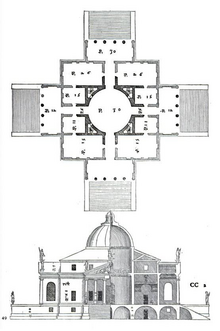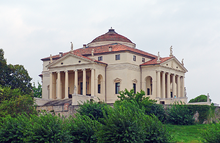La Rotonda
La Rotonda is a villa near Vicenza in northern Italy . The real name is Villa Almerico Capra , but it is known under the name La Rotonda or Villa Rotonda . Designed by the Italian Renaissance - architect Andrea Palladio . The villa was planned and built around 1567–1571. The builder was Bishop Paolo Almerico, a high official of Pius IV. In 1994, together with the old town of Vicenza and other Palladian villas, it was included in the UNESCO list of world cultural heritage .
Location and surroundings
The villa is located on a hill on the south-eastern outskirts of Vicenza. From here you have a wonderful view over the Venetian landscape in all four directions.
“The location is one of the most graceful and enjoyable that one can find. The house is located on an easy-to-climb hill, which is bordered on one side by the Bacchiglione, a navigable river, and on the other side is surrounded by other lovely hills that look like a big theater [...] "
“Today I visited the magnificent house called the Rotonda, half an hour from the city at a pleasant height. It is a square building that encloses a round hall lit from above. From all four sides one climbs up wide stairs and each time comes into a vestibule, which is formed by six Corinthian columns. Perhaps architecture has never taken its luxury higher. The space occupied by the stairs and lobbies is much larger than that of the house itself; for every single page would be satisfying as a view of a temple. Inside you can call it habitable, but not ordinary. The hall is of the most beautiful proportions, as are the rooms; but they would scarcely suffice for the needs of a noble family for a summer stay. But you can see it in the whole area from all sides in the most wonderful way. The variety is great, in which its main mass moves at the same time as the protruding pillars before the eyes of the wandering, and the intention of the owner has been fully achieved, who wanted to leave behind a great entailment and at the same time a sensual monument of his property. And as the building is now seen in its glory from all points in the area, so the view from it is likewise the most pleasant. One sees the Bachiglione flowing, ships leading down from Verona towards the Brenta; one overlooks the vast estates that Marchese Capra wanted to keep undivided with his family. "
The diagonals and corners of the villa are aligned with the cardinal points, with the corner to the left of the entrance pointing north.
function
During the Renaissance, the beauty of the landscape was rediscovered and the “simple life” in the country as a complement to city life. The villa was not intended as an agricultural utility building or purely residential building. It was a place of distraction, relaxation and edification, especially in the summer months. The utility rooms (wine cellar, kitchen, etc.) were all in the basement, the piano nobile remained free for use as a "leisure house". One can assume that festivals and cultural events of all kinds were held here. Much more important than the practical use of the house, however, was probably the creation of an ideal building whose aesthetics sought to match the ancient models.
The Capra family bought the villa in 1591 and the Valmarana family in 1911, who opened it to the public in 1986. Today the Villa Rotonda is a museum.
architecture

Palladio had studied ancient Roman architecture in depth . His sketches of the Romulus and Vesta temples, but also the Pantheon, were certainly strong models for his design. The rotunda with the dome attached as the central area indicates the orientation towards Roman round temples. The floor plan is based on the basic shapes of a square and circle and has the shape of a Greek cross . In front of the building cube, the same open facade is placed on all four sides: a classic portico made up of six Ionic columns, crowned by a triangular gable. Wide steps lead from the park up to the piano nobile . From there one arrives at the Sala centrale , the central domed hall. Its pompous decoration with stucco and frescoes from the 1590s does not correspond to Palladio's intentions.
The villa is divided into three floors: the basement with the utility rooms , the piano nobile with the representative rooms and above that a mezzanine floor , on which the everyday living spaces were located, which was probably added to the design at the client's request and was only completed under Vincenzo Scamozzi .
“Since you can enjoy wonderful views from every side, some of which capture the surrounding area, others extend further and still others only end on the horizon, loggias have been built on all four sides, below which, as well as below the main hall, the rooms for the use and convenience of the servants. The main hall is in the middle, is round and receives its light from above. The chambers are half floors. Above the large rooms, the vaults of which are as high as those of the first type of vaulting and which surround the main hall, there is a gallery fifteen and a half feet wide. At the outer ends of the pedestals that support the stairs of the loggias are marble statues by the hand of the sculptor Lorenzo Vicento. "
The statues on the staircases are by Lorenzo Rubini (before 1570), the statues on the portico and roofs by Giambattista Albanese (1599–1606). In a garden niche is the sculpture group Orazio Marinalis Herakles with the goat Amaltheia in allusion to the client's name Capra (German: goat).
References in the history of architecture
- Rocca Pisana ( Villa Pisani ) by Scamozzi in Italy (1576)
- Mereworth Castle (Mereworth Castle) built by Colen Campbell in England (1720s)
- Chiswick House (from 1725)
- Monticello by Jefferson in the USA (from 1768)
- Villa Rosa by Gottfried Semper in Dresden (1839)
- Contemporary Gallery by Oswald Mathias Ungers in Hamburg (1995)
- Grave chapel on the Württemberg in Stuttgart (1820–24) by Giovanni Salucci
literature
- James S. Ackerman: The villa. Form and Ideology of Country Houses . Thames and Hudson, London 1995, ISBN 0-500-27744-3 .
- Reinhard Bentmann , Michael Müller : The villa as a manorial architecture. An art and social history analysis . European publishing company, Hamburg 1992, ISBN 3-434-50009-X .
- Johann Wolfgang von Goethe : Italian journey . Deutscher Taschenbuch Verlag , Munich 1786, ISBN 3-423-12402-4 , September 9, 21, evening ( projekt-gutenberg.org ).
- Kornelia Imesch: Magnificenza as an architectural category. Individual self-expression versus aesthetic realization of community in Palladio's and Scamozzi's villas . Athena, Oberhausen 2003, ISBN 3-89896-153-2 (also: Zurich, Univ., Habil.-Schr., 2002).
- Kurt Jauslin: A house for Canonicus Almerigo. Palladio's Villa Rotonda as a reconstruction of the aesthetic . Projektverlag, Dortmund 1995, ISBN 3-928861-30-1 .
- Wolfram Prinz: Chambord Castle and the Villa Rotonda in Vicenza. Studies in iconology (= Frankfurt research on art . Volume 7 ). Mann, Berlin 1980, ISBN 3-7861-1219-3 .
- Camillo Semenzato: The Rotonda . 2nd edition. Gino Rossato Editore, Novale 2007, ISBN 978-88-8130-101-0 .
Web links
- Museum Villa "La Rotonda"
- andrea-palladio.de - biography, extensive catalog raisonné etc.
- Entry at greatbuildings.com
- Photos of the interior
- Entry on the UNESCO World Heritage Center website ( English and French ).
Individual evidence
- ↑ Manfred Wundram (Ed.): Reclam's Art Guide Italy. Volume 2: Upper Italy East (= Reclams Universal Library . 10001/16). Edited by Erich Egg , Erich Hubala u. a. Reclam, Stuttgart 1965, p. 1129.
- ^ A b Transfer by Andreas Beyer and Ulrich Schütte from Andrea Palladio: The four books on architecture. Translated from the Italian and published after the Venice 1570 edition. 3rd, revised edition. Verlag für Architektur Artemis, Zurich u. a. 1988, ISBN 3-7608-8116-5 , p. 132.
- ↑ Johann Wolfgang Goethe
Coordinates: 45 ° 31 '53.3 " N , 11 ° 33' 35.9" E



